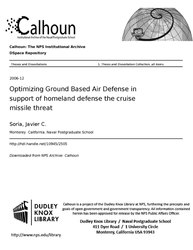File:Optimizing Ground Based Air Defense in support of homeland defense the cruise missile threat (IA optimizingground109452505).pdf

Original file (1,275 × 1,650 pixels, file size: 1.59 MB, MIME type: application/pdf, 96 pages)
| This is a file from the Wikimedia Commons. Information from its description page there is shown below. Commons is a freely licensed media file repository. You can help. |
Summary
| Optimizing Ground Based Air Defense in support of homeland defense the cruise missile threat
( |
||
|---|---|---|
| Author |
Soria, Javier C. |
|
| Title |
Optimizing Ground Based Air Defense in support of homeland defense the cruise missile threat |
|
| Publisher |
Monterey California. Naval Postgraduate School |
|
| Description |
Since the attacks of September 11th, 2001 involving commercial aircraft used as missiles to attack critical assets located within the United States, the U.S has worked diligently to enhance its military air defense posture. Air defense of critical U.S. assets and National Special Security Events (NSSE) have been enhanced by adding static and proposed deployable Ground Based Air Defense (GBAD) systems designed to provide a [beta]last line[gamma] of defense from air attacks over U.S. soil. Currently this last line of defense is incorporated with the air and maritime military air defense forces providing a [beta]defense in depth[gamma] over critical assets, but does not support the air and maritime air defense over broader ranges of U.S. soil where critical assets do not exist. As the U.S. continues to enhance its air defense posture around critical assets and high priority events against terrorist attacks from the air, it is reasonable to assume that the terrorists may adjust their strategy for air attacks. The terrorists may deem it more beneficial to attack targets which lack a last line defense. It is therefore critical to examine new means and methods to provide GBAD in areas which may be determined to be less lucrative targets. In addition to the proposed alternate terrorist strategy, it is also reasonable to assume that increased security measures in the Transportation Security Administration (TSA) will deter the terrorists from attempting another hijacking event; thus forcing them to seek other means of attack. Cruise missiles (CM) are a cheap and effective means of causing limited destruction. Cruise missiles can be programmed to maneuver and operate at various altitudes and are small enough to be transported with little to no visibility. A cruise missile in the wrong hands could find its way to within miles of the U.S. borders and coastlines. If launched; a cruise missile could engage random targets throughout the U.S., such as malls or schools, and cause a major upset to our national security. Therefore, a defense system should be established which incorporates GBAD that is capable of engaging the CM threat with little to no notice, over the entire U.S. border and coastal regions. Subjects: Terrorism; Cruise missiles; Civil defense; United States |
|
| Language | English | |
| Publication date | December 2006 | |
| Current location |
IA Collections: navalpostgraduateschoollibrary; fedlink |
|
| Accession number |
optimizingground109452505 |
|
| Source | ||
| Permission (Reusing this file) |
Approved for public release, distribution unlimited | |
Licensing
| Public domainPublic domainfalsefalse |
This work is in the public domain in the United States because it is a work prepared by an officer or employee of the United States Government as part of that person’s official duties under the terms of Title 17, Chapter 1, Section 105 of the US Code.
Note: This only applies to original works of the Federal Government and not to the work of any individual U.S. state, territory, commonwealth, county, municipality, or any other subdivision. This template also does not apply to postage stamp designs published by the United States Postal Service since 1978. (See § 313.6(C)(1) of Compendium of U.S. Copyright Office Practices). It also does not apply to certain US coins; see The US Mint Terms of Use.
|
 | |
| This file has been identified as being free of known restrictions under copyright law, including all related and neighboring rights. | ||
https://creativecommons.org/publicdomain/mark/1.0/PDMCreative Commons Public Domain Mark 1.0falsefalse
Captions
Items portrayed in this file
depicts
File history
Click on a date/time to view the file as it appeared at that time.
| Date/Time | Thumbnail | Dimensions | User | Comment | |
|---|---|---|---|---|---|
| current | 15:10, 23 July 2020 |  | 1,275 × 1,650, 96 pages (1.59 MB) | Fæ | FEDLINK - United States Federal Collection optimizingground109452505 (User talk:Fæ/IA books#Fork8) (batch 1993-2020 #24147) |
File usage
Metadata
This file contains additional information, probably added from the digital camera or scanner used to create or digitize it.
If the file has been modified from its original state, some details may not fully reflect the modified file.
| Short title | Optimizing Ground Based Air Defense in support of homeland defense the cruise missile threat |
|---|---|
| Author | Soria, Javier C. |
| Software used | Soria, Javier C. |
| Conversion program | Acrobat Distiller 6.0.1 (Windows) |
| Encrypted | no |
| Page size | 612 x 792 pts (letter) |
| Version of PDF format | 1.4 |


